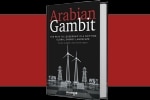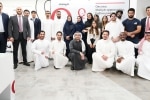Adopting a circular economic model could save GCC US$138 billion between 2020 and 2030
11/02/19
A new report published at the World Government Summit reveals how Gulf Cooperation Council (GCC) countries can save almost US$138 billion by 2030 if they adopt a circular economic model, corresponding to nearly 1 percent of the region’s cumulative GDP between 2020 and 2030. The report, developed in collaboration with the World Government Summit and the Ideation Center, the leading think tank for Strategy& Middle East, part of the PwC network, is titled “Putting GCC cities in the loop: Sustainable growth in a circular economy”. Under the prevalent linear economic model, the region is depleting its resources at an accelerated rate, generating unprecedented waste and emissions that are causing enormous social, economic and environmental damage.
Marwan Bejjani, partner with Strategy& Middle East, said: “GCC countries need to move away from the current linear model described as ‘take, make, use, waste.’ For instance, the region’s households are responsible for the highest consumption of electricity in the world, while their gasoline consumption per capita compares to that of North America, the region with the most intensive usage of gasoline. This is not sustainable, so there is a pressing need to move to an alternative economic model before it is too late.”
The circular economy is a holistic solution that seeks to enhance the value and productivity of material resources, and minimize any value leakage in order to have a positive economic and environmental effect. The concept derives its inspiration from nature’s biological and technical cycles by creating a closed loop material cycle.
The Ideation Center at Strategy& has defined a circular economy framework, governed by three principles:
- Optimizing the consumption of finite resources (production stage). This involves sourcing renewable materials; designing products that can be disassembled, reused, repaired, and/or upcycled; and using resources efficiently.
- Maximizing product utilization (production and distribution stages). This involves dematerializing products: instead of selling products through a one-time transaction, manufacturers or distributors agree a contract with customers to provide the product, maintain it, and eventually replace or recover it. It also involves the practice of sharing durable assets such as cars, rooms and appliances; and using products in a manner that ensures durability.
- Recovering by-products and waste (production and consumption stages). This involves refurbishing and remanufacturing products; recovering by-products from the manufacturing process and reintroducing them into the production cycle; and retrieving discarded materials after consumption and reusing them for new products.
Dr. Yahya Anouti, principal with Strategy& Middle East, said: “To ensure a sustainable economic growth it is critical that the region adopts the concept of the circular economy, starting with our foundation: the city. By incorporating circular principles into the way we construct and utilize buildings, transport people and goods, and consume products and utilities, the region can save between 2020 and 2030 up to 138 USD billions and extraordinary 150 million ton in C02 emissions, virtually the total emissions of the Netherlands in 2015.”
“To drive these circular initiatives it is essential to have a comprehensive national framework that ensures that everyone is moving in the same direction. This would require a coordinated implementation, financial incentives to encourage the right behaviors and public awareness campaigns, targeting citizens and corporations”, added Anouti.
Circular economy benefits for GCC cities
- A flexible and durable built environment: The GCC construction sector produces 35 to 40 percent of the waste in GCC cities, compared to 25 to 30 percent in the EU. “Implementing circular initiatives in the built environment would produce benefits of more than $23 billion between 2020 and 2030. For instance, sharing space, or using it for multiple purposes, can increase the utilization of floor space by up to 30%, thereby reducing demand for new buildings and other additional burdens on existing resources. Broader adoption of modal construction, or using 3D printing for building components, would also help to implement the circular concept, not least by reducing waste”, said Bejjani.
- A clean and lean mobility system: Considerable economic, social, and environmental value can be generated through a circular model in mobility by reducing congestion, traffic accidents, and fuel consumption, along with the costs associated with them. A circular mobility model could generate cumulative benefits in the GCC of US$69 billion from 2020 to 2030. Relevant opportunities could also help reduce up to 28 million tons of C02 over the same period, the equivalent of taking 577,000 cars off the road – nearly half the number of personal cars currently in use in the UAE. Circular initiatives in the mobility sector include implementing intermodal transportation systems, which are vital in reducing dependence on passenger cars. Vehicle sharing, would reduce the number of personal car journeys and electric vehicles would cut fuel consumption significantly.
- An environmentally aware community: GCC consumers exhibit wasteful behavior in their consumption of electricity, water, and food. Boosting circularity within households could generate cumulative benefits of US$46 billion between 2020 and 2030. A reduction of up to 117 million tons of C02 could also be achieved over the same period through electricity savings – slightly more than the equivalent annual C02 emissions of the Czech Republic in 2015.
The report also outlines the steps that GCC governments can take to begin the transition to a circular economy and reap the desired benefits. This includes integrating their efforts in a comprehensive national framework, establishing a strategic council to guide the implementation, educating their populations about the environmental impact of their consumption habits, and changing how they themselves procure and consume assets.
“GCC countries are moving toward a path of sustainability, and have set a number of targets relating to renewable energy generation and recycling. However, they still lack a holistic approach for increasing circularity in line with the three principles of the circular economy. These principles are to optimize the usage of resources, maximize the life of products, and minimize and create value out of waste,” concluded Alice Klat, Director of the Ideation Center, Strategy& think tank in the Middle East.
















Menu